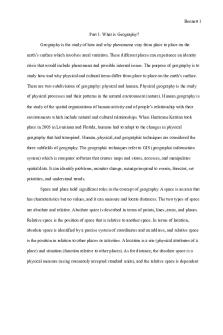Sandhu 3 geography 10 PDF

| Title | Sandhu 3 geography 10 |
|---|---|
| Course | Cultural Geography |
| Institution | San José State University |
| Pages | 3 |
| File Size | 52.4 KB |
| File Type | |
| Total Downloads | 6 |
| Total Views | 120 |
Summary
geography 10...
Description
Sanampreet Sandhu Geog 1 18 February 2018 3.How do the three mechanisms of conduction, convection and radiation move energy from one place to another? a.
Conduction- The process by which heat or electricity is directly transmitted through a
substance when these is a difference of temperature or of electrical potential between connected regions, without movement of the materials. For example, the transmission of nerves impulses from axons. b.
Convection- the movement caused within a fluid by the tendency of hotter and therefore
less dense material to rise, and colder, denser material to sink under the influence of gravity, which in turn transfers heat. c.
Radiation- the emission of energy as electromagnetic waves or as moving subatomic
particles of high energy. 4.
Outline the three laws of thermodynamics.
a.
1st- when energy passes as heat or as matter in or out of a system. It is also known as law
of conservation of energy. It states that energy can neither be created nor destroyed, energy can only be transferred or changed from one form to another b.
2nd- says that entropy of any isolated system always increased. Isolated systems
spontaneously evolve towards thermal equilibrium. Furthermore, the state of maximum entropy of the system is what states this.
c.
3rd- states that the entropy of a system approaches a constant value as the temperature
approaches absolute zero. The entropy of a system at absolute zero is typically zero, and in all cases is determined only by the number of different ground states it has. 5.
What is radiation? How is it created? What factors determine its quantity and quality?
a.
Radiation is energy travelling through space and can penetrate various materials. It is
created through energy traveling through space and is produced by unstable atoms. Radiating can be affected by the space it is in, for example it feeds off of other radioactive atoms 6.
Verbally (i.e., using words rather than equations) define the Stefan-Boltzmann Law. What
does it describe? 7.
Formulated in 1879 by Austrian physicist Josef Stefan as a result of his experimental
studies. In this equation E is the radiant heat energy emitted from a unit area in one second and t is the absolute temperature, in kelvins. The Greek letter sigma represents the constant of proportionality, called the Stefan-Boltzmann constant. This constant has the value of 5.670367 x 10 ^-8 watt per metre^2 per K^4. So basically, heat energy equals constant of proportionality multiplies by absolute temperature to the power of 4. 8.
Verbally define the Wien's Law. What does it describe?
a.
The peak of wavelength equals the constant of proportionality called the Wien's
displacement constant divided by the absolute temperature. It decides the radiation curve for different peaks at a wavelength inversely proportional to the temperature. 9.
How does the Sun create the energy that drives most systems on the Earth?
a.
Energy from the sun heats earth's surface, warms the atmosphere, provides energy for
photosynthesis, causes evaporation, drives the weather and water cycles, and powers the ocean currents.
10. How does the tilt of the Earth's axis influence the annual solar insolation received at a site located at 50 degrees North latitude? a.
Places like Alaska and anywhere north tend to get a lot less light because the sun hits the
0 point on the latitude most for example tropical regions. The earth makes an orbital journey around the run and we are titles about 23 degrees so this is why 50 degree has a solar isolation, for example, Alaska stays dark for 30 days once a year 11. What influence does Earth rotation have on solar insolation received at the equator? The earth's rotation controls the angle of the solar rays and this angle will control the intensity of solar radiation that is received by earth 12. How does angle of incidence control the intensity of solar radiation received at the Earth's surface? The intensity of solar radiation is strictly due to the angle of incidence, which can be defined as the angle at which the Sun's rays strike the Earth's surface. Essentially, if the Sun is positioned directly overhead or 90° from the horizon, then the sun strikes the surface of the Earth at right angles and is most intense, which is why the weather is so tropical at the equator....
Similar Free PDFs

Sandhu 3 geography 10
- 3 Pages

Geography Unit 3 Glossary
- 3 Pages

Geography Assignment 3
- 5 Pages

Human geography test 3 review
- 10 Pages

Climograms - Geography
- 1 Pages

HSC Geography
- 59 Pages

Geography test
- 9 Pages

Geography/Place
- 3 Pages
Popular Institutions
- Tinajero National High School - Annex
- Politeknik Caltex Riau
- Yokohama City University
- SGT University
- University of Al-Qadisiyah
- Divine Word College of Vigan
- Techniek College Rotterdam
- Universidade de Santiago
- Universiti Teknologi MARA Cawangan Johor Kampus Pasir Gudang
- Poltekkes Kemenkes Yogyakarta
- Baguio City National High School
- Colegio san marcos
- preparatoria uno
- Centro de Bachillerato Tecnológico Industrial y de Servicios No. 107
- Dalian Maritime University
- Quang Trung Secondary School
- Colegio Tecnológico en Informática
- Corporación Regional de Educación Superior
- Grupo CEDVA
- Dar Al Uloom University
- Centro de Estudios Preuniversitarios de la Universidad Nacional de Ingeniería
- 上智大学
- Aakash International School, Nuna Majara
- San Felipe Neri Catholic School
- Kang Chiao International School - New Taipei City
- Misamis Occidental National High School
- Institución Educativa Escuela Normal Juan Ladrilleros
- Kolehiyo ng Pantukan
- Batanes State College
- Instituto Continental
- Sekolah Menengah Kejuruan Kesehatan Kaltara (Tarakan)
- Colegio de La Inmaculada Concepcion - Cebu







